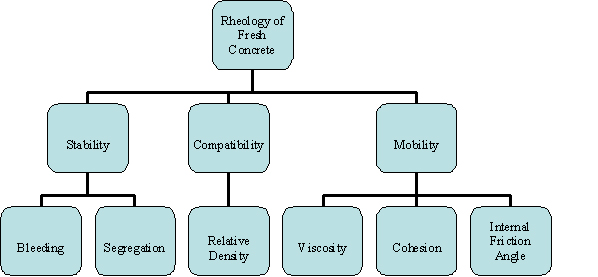In recent years research has focused on how to improve the performance of concrete, especially on topics regarding how to increase the strength, durability and flowability of concrete. At the same time there is extensive study on how to evaluate and predict these performance indicators. High strength and high performance concretes have become the most interesting topic in the area of concrete development since 1980s, and it is now possible to have structures that are built with concrete having compressive strength over 100 MPa. However, it soon became apparent that compressive strength as material property is not enough to characterize the quality of the material.
The only material feature that has not been given interest, until recently, is the ability of concrete to flow. Most recent research in the concrete area focuses on techniques that will combine strength and durability with this third main property of concrete. However, high workability concrete is still something quite unknown to many researchers. There is still a lot of uncertainty and debate concerning the appropriate mixing proportions and methodologies. At the past, several attempts were made to link fresh concrete properties with measurable quantities. For the purpose of studying the concrete flow during fresh state, the scientific community has chosen the theory of rheology as the tool that will explain properly the flow characteristics of such a complex composite as concrete.
Rheology and Concrete Flow
Rheology is the science of the deformation and flow of matter, and the emphasis on flow means that it is concerned with the relationships between stress, strain, rate of strain and time (de Larrard, 1999). Flow is concerned with the relative movement of adjacent elements of liquid and has two basic types, shear and extensional flow. In case of cementitious composites, shear flow is of primary interest. In shear flows liquid elements flow over or past each other, while in extensional flows, elements flow towards or away from each other. In a shear flow, imaginary parallel layers of liquid move in response to a shear stress to produce a velocity gradient, which is referred to as the shear rate, equivalent to the rate of increase in shear strain (Douglas et.al., 1995). In the rheology of fresh concrete, the laws governing the shear deformations of the matrix at the fresh state are still investigated.
Ritchie was the first that attempted to define the flow of concrete by associating it with various effects such as bleeding, sedimentation and density (ACI C309, 1981). Consequently, he subdivided rheology of fresh concrete into three fundamental properties, namely: stability, compatibility and mobility. Stability is connected with bleeding and segregation, compatibility is equivalent to density and mobility is related to internal friction angle, bonding force and viscosity. Although, Ritchie’s approach was innovative when developed it incorporated one major drawback. Even though the major parameters associated with the rheology of fresh concrete had been identified (see Figure below), there was not an apparent relationship between them. For example the three factors that influence the mobility of a mix may well affect compatibility.
Figure: Parameters of rheology of fresh concrete (ACI C309, 1981)
From late 1970s many researchers started treating fresh concrete as a fluid and used fluid rheology methods to describe concrete flow (Ferraris and Larrard, 1998a). Concrete in its fresh state can be thought of as a fluid provided that a certain degree of flow can be achieved and that concrete is homogeneous. As mentioned in the opening paragraph of this section the type of flow that characterizes concrete flow is the shear flow. To demonstrate the shear behavior of fresh concrete, a sample has to be submitted to shear deformations, either in a controlled stress or controlled strain rate conditions.
Parameters Affecting Rheology of Concrete
There are various parameters that strongly influence the rheological properties of fresh concrete. The following table summarizes these factors and their impact on the properties of flow of fresh concrete.
Table: Factors affecting flow of fresh concrete and their impact on the rheological properties (after Flatt et.al., 2004).
References
ACI Committee 309, “Behavior of Fresh Concrete During Vibration”, ACI Materials Journal, Vol. 78, No. 3, 1981, pp. 36-53
Douglas J.F., Gassiorek J.M. and Swaffield J.A. “Fluid Mechanics”, Longman Scientific and Technical, Third Edition, 1995, ISBN 0582234085, pp. 287-292
Ferraris C.F. and Larrard F. de, “Modified Slump Test to Measure Rheological
Parameters of Fresh Concrete” Cement, Concrete and Aggregates, Vol. 20, No. 2, 1998a, pp. 241-247
Flatt R.J., Martys N. and Bergström L., “The Rheology of Cementitious Materials”, Materials Research Society, MRS Bulletin, Vol. 29, No. 5, 2004, pp. 314-318
Larrard F de “Why Rheology Matters”, Concrete International, Vol. 21, No. 8, 1999, pp. 79-81





